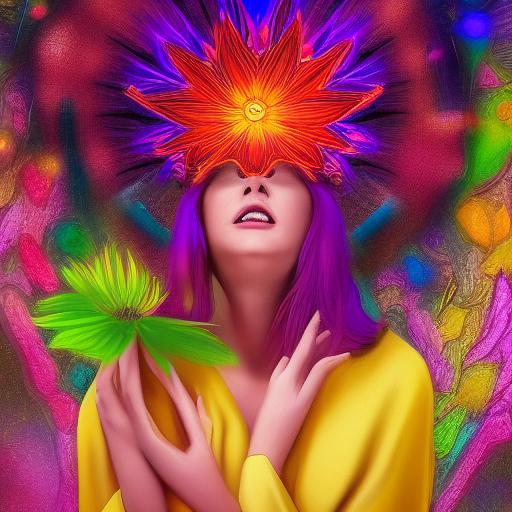How to write this prompt?
Here is a breakdown of the prompt into individual components and their potential impact on the image output:
- Artwork type: The prompt specifies that the image should be a digital 2D fantasy psychedelic artwork painting, which sets the tone and style of the artwork. This type of artwork usually features bold colors, intricate patterns, and surreal elements that evoke a sense of otherworldliness.
- Subject and setting: The main subject of the artwork is a woman holding a laughing flower, captured in a low angle lens. The setting is a street-level view featuring a colorful mural with a bokeh effect in the background. This gives the artist a clear visual reference to work with and sets the scene for the image.
- Resolution and rendering: The prompt specifies that the image should be rendered in 8k UHD with ultra-realistic and highly detailed using Houdini render. This means that the image will be highly detailed, and the artist can focus on intricate details that will enhance the realism of the artwork.
- Lighting: The prompt includes a dramatic backlight that creates a glowing effect around the woman and the flower. This adds depth and dimensionality to the image and highlights the main subject of the artwork.
By combining these individual elements in the prompt, an AI model can generate an image that meets the specified criteria. The use of a specific software like Houdini, the resolution, the low-angle lens, the bokeh effect, and the dramatic backlight all work together to create a distinct mood and atmosphere in the final image. By providing such specific details in the prompt, artists and designers can create highly detailed and customized images.
What is Houdini render, and how is it used in digital artwork?
Houdini is a 3D animation software that allows artists to create highly detailed and realistic digital images. Houdini render is a rendering engine that is used to produce high-quality images and animations by simulating complex lighting and shading effects. Artists can use Houdini render to create photorealistic images, and it is commonly used in the film and video game industries.
Why is backlighting important in digital artwork, and how can it enhance an image?
Backlighting is important in digital artwork because it can add depth and dimensionality to the image. By placing a light source behind the subject, the artist can create a glowing effect that draws the viewer’s attention to the main subject of the image. This technique can be used to highlight important elements of the artwork, such as the woman and the laughing flower in the AI image prompt.
Who are some famous artists known for creating psychedelic artwork, and what are some defining characteristics of their style?
Some famous artists known for creating psychedelic artwork include Alex Grey, Salvador Dali, and Peter Max. Psychedelic artwork often features bold colors, intricate patterns, and surreal elements that evoke a sense of otherworldliness. These artists also often incorporate spiritual or mystical themes into their work, which adds to the psychedelic nature of their style.
Can AI art generation prompts be used for commercial purposes?
Yes, AI art generation prompts can be used for commercial purposes. The generated images can be used in a variety of ways, such as advertising, branding, and product design. However, it is important to note that the ownership and copyright of the generated images can be a complex issue. Depending on the terms of use of the AI model or dataset, the ownership of the generated images can belong to the AI company, the creator of the model, or the person who used the AI to generate the image. It is important to be aware of the legal implications before using AI-generated art for commercial purposes.
Can AI-generated art be improved or edited by humans?
Yes, AI-generated art can be improved or edited by humans. While AI models are becoming increasingly advanced, they still lack the creativity and intuition of human artists. Humans can add their own unique perspective and style to the generated images, refining and improving them to suit their specific needs. For example, a human artist could add additional details or adjust the color scheme of an AI-generated image to better align with a specific brand’s aesthetics. It is worth noting that the process of improving or editing AI-generated art can be time-consuming, and it requires a certain level of technical expertise to work with AI-generated files. However, with the right skills and knowledge, humans can use AI-generated art as a starting point and take it to new heights.
Enhance your designs with stunning AI-generated art using Visual Paradigm Online. With just a few clicks, you can incorporate unique and visually appealing graphics into your projects, thanks to the platform’s user-friendly interface and a wide selection of design templates and assets. Experiment with various styles and layouts until you achieve the perfect combination for your needs. Try Visual Paradigm Online today and take your designs to the next level!


